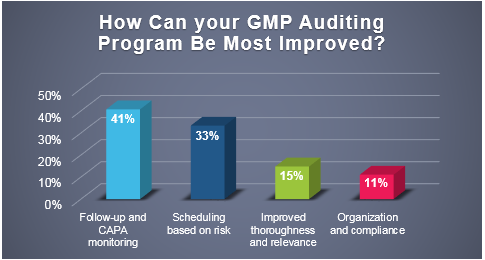December 9, 2024

December 9, 2024

In the decades since the FDA first introduced Good Manufacturing Practice (GMP) regulations, the drug and device industry has undergone significant transformation. While the core principles of GMP—safety, efficacy, and quality—remain foundational, the way manufacturers achieve these goals has evolved to keep pace with increasing complexity. Today's manufacturing environment is shaped by the rise of advanced therapies, including biologics, cell and gene therapies, and personalized medicine, each demanding highly specialized processes and controls. Alongside these innovations, global supply chains have expanded, requiring manufacturers to coordinate with international partners, each subject to unique regulatory standards. Additionally, as regulators worldwide adopt more rigorous data integrity and compliance requirements, scrutiny of quality systems has intensified.
In the light of these challenges, robust Quality Management Systems (QMS) have become indispensable. Modern QMS frameworks must be more than compliant; they must be adaptive, proactive, and seamlessly integrated with every layer of manufacturing, from production systems to supply chain management. Whether you're enhancing an existing system or establishing a new one, understanding these modern QMS components is essential for navigating the evolving regulatory landscape, ensuring product safety, and achieving sustained excellence in a complex global market.
In today's drug and device manufacturing landscape, a QMS is built upon a framework of interdependent pillars, each designed to ensure the consistent production of safe, effective, and high-quality products. These pillars must work in concert, forming a comprehensive QMS that is adaptable to new technologies, regulatory expectations, and the intricacies of advanced therapies. Additionally, the degree of focus on each pillar can shift depending on the level of outsourcing involved. The following are the foundational pillars that support a resilient and compliant QMS:
At the core of any QMS is the Quality System itself, establishing policies, procedures, and the framework needed for consistent quality oversight across all activities. This system integrates and unifies all other pillars to align with regulatory requirements and organizational standards. In environments with significant outsourcing, a strong Quality System becomes critical for managing external partners. It provides the tools for setting quality expectations, conducting regular audits, and implementing corrective actions if needed. A robust quality governance system enables seamless integration of third-party vendors while upholding quality standards and fostering a culture of compliance and risk mitigation across all partners.
The Production System encompasses the processes, batch records, and controls for the manufacturing of drug products. For companies that outsource some or all their production, rigorous oversight of contract manufacturers is essential. Establishing clear quality agreements and frequent performance reviews with these partners ensures adherence to validated methods and compliance with batch record requirements. In cases where production remains in-house, the focus may instead be on process improvements, such as implementing digital batch record systems and automated data collection for continuous monitoring and efficiency gains. The production system pillar ensures consistent, compliant, and reliable production processes, whether internal or external.
The Facilities and Equipment System focuses on maintaining a controlled environment that prevents contamination and safeguards product quality. This includes everything from HVAC and water systems to specialized equipment in manufacturing and laboratories. For operations that outsource manufacturing, the responsibility for facilities and equipment may rest with contract manufacturers, yet the sponsor company still needs to ensure that these systems meet regulatory standards through audits and quality assessments. When facilities and equipment are managed in-house, companies have direct control over validation, calibration, and maintenance but may need to implement robust tracking systems and adopt predictive maintenance practices to uphold quality standards.
The Laboratory Control System governs all quality testing, from raw materials to finished products, ensuring that every batch meets established specifications. For companies that outsource laboratory services, supplier qualification and regular audits of testing facilities are essential to ensure data integrity and compliance. Clear data transfer protocols and review mechanisms are crucial to prevent discrepancies. For in-house labs, data integrity, document control, and trend monitoring are key, supported by advanced Laboratory Information Management Systems (LIMS) and data analytics to streamline workflows and uphold quality. Either way, a well-defined Laboratory Control System helps mitigate risks associated with outsourced testing.
The Materials Control System manages the lifecycle of materials from supplier qualification and raw material handling to final product storage. With global supply chains and potential variability in material quality, this system is vital for mitigating risks, especially if raw materials are sourced from external suppliers. When materials procurement or handling is outsourced, strong supplier qualification, traceability, and quality agreements become paramount to ensure that only compliant, high-quality materials enter the production process. For in-house materials control, the emphasis may shift toward real-time inventory tracking, quality checks, and storage optimization to prevent delays or material discrepancies.
The Packaging and Labeling System ensures that drug products are properly packaged and labeled in compliance with regulations, delivering essential information to end users. Outsourcing packaging and labeling introduce complexities like managing serialized labels, tracking-and-trace requirements, and coordinating logistics. For companies that outsource this pillar, regular audits and comprehensive quality agreements with partners are essential to maintain compliance and prevent mix-ups or mislabeling. In-house packaging operations allow for more direct oversight and flexibility, though they may require automation and quality control investment to ensure precision and consistency.
Each of these pillars is essential for establishing a Quality Management System that supports both in-house and outsourced operations. The degree of focus on each pillar may vary depending on a company's outsourcing strategy, but all pillars must ultimately align to deliver a consistent, high-quality product. By building adaptable systems, defining clear roles and quality agreements with external partners, and maintaining regular oversight, manufacturers can effectively uphold compliance and product integrity amid the evolving demands of the drug and device industries.
While the six pillars form the foundation of a Quality Management System, additional supports are crucial to sustain and strengthen this structure. Elements such as a skilled and engaged workforce, a commitment to data integrity, proactive risk management, and thorough auditing practices work together to enhance the effectiveness of each pillar. These supports ensure that the quality system not only meets regulatory requirements but also adapts to the complexities and evolving demands of modern drug and device manufacturing. Together, they create a resilient framework that upholds quality and compliance at every level.
At the core of every quality management system is the human element. Even with the best systems, equipment, and protocols in place, it's ultimately the people who ensure that quality standards are met. Successful quality systems depend on a well-trained workforce that understands the significance of compliance, is engaged in maintaining quality, and is dedicated to continuous improvement.
Data integrity is foundational to regulatory compliance and critical to ensuring that quality decisions are based on accurate information. Drug and device manufacturing relies on data to verify process control, validate quality outcomes, and demonstrate compliance with regulatory expectations.
Risk management is essential for identifying, analyzing, and mitigating potential issues before they affect product quality or patient safety. Adopting a proactive approach to risk enables companies to address potential quality threats and build resilience in their processes.
Audits are an essential mechanism to verify that quality systems are functioning as intended, providing both internal assurance and preparation for regulatory inspections. They help maintain a "state of readiness" by identifying gaps, areas for improvement, and best practices that can enhance overall system performance.
In today's complex and highly regulated life science landscape, a robust Quality Management System is not just a regulatory necessity—it's a critical driver of product safety, effectiveness, and organizational success. By establishing a solid foundation through the six pillars of quality, and supporting them with the right human resources, data integrity, risk management strategies, and audit practices, companies can build a resilient, compliant, and agile quality system that adapts to evolving industry demands.
As the industry faces challenges like the rise of biologics, cell and gene therapies, and increased global oversight, the importance of a comprehensive, well-executed Quality Management System has never been clearer. Embracing these components, refining processes, and fostering a culture of continuous improvement will ensure that quality is consistently prioritized, ultimately helping to bring safe and effective products to market faster and more efficiently.
A successful Quality Management System is a journey, not a destination. By investing in the right systems and practices today, you'll be prepared for the evolving challenges of tomorrow—ensuring not only regulatory compliance but the long-term success of your organization.

Vice President, Compliance & Quality Assurance
This blog post has been updated since its original published date: August 30, 2017
TAGS: Quality & Compliance QMS FDA
January 6, 2022
Although domestic travel is slowly ramping up, companies may still consider virtual factory acceptance testing (FAT). FAT is an optional step in the life sciences’ process of purchasing factory...

November 29, 2018
Recently, ProPharma conducted a poll to quality professionals across the country to understand the challenges that FDA regulated companies face in managing their GMP auditing programs. As depicted in...